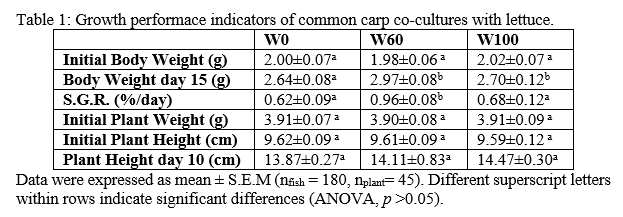GROWTH PERFORMANCE OF COMMON CARP Cyprinus carpio FED A DIET BASED ON CONVERSION OF FISH SLUDGE INTO INSECT MEAL AND CO-CULTURED WITH LETTUCE Lactuca sativa IN A ONE-LOOP LABORATORY AQUAPONIC SYSTEM
Introduction
Aquaponics, as an integrated system combining aquaculture and hydroponics, has emerged as a promising solution for sustainable food production , particul Insects provide a promising means to bioconvert organic wastes and side-streams into a protein-rich biomass. In this context, the common carp (C. carpio), a resilient and extensively cultivated freshwater species, can be efficiently co-cultivated with leafy vegetables such as lettuce (L. sativa ), which is distinguished by its abbreviated growth cycle and elevated market value. In aquaponic systems, a considerable amount of solid wastes (fish sludge) is accumulated, the management of which has become a significant issue. The disposal of these water pollutants, containing high levels of nitrogen and phosphorus, poses a serious environmental challenge. Similarly, hydroponic and greenhouse cultivation generate residues in the form of leaves, stems and discarded vegetables, which are mostly wasted. Therefore, effective waste management solutions are necessary for both wastes. One potential approach to address this issue is the upcycling of these non-value organic wastes by using insects as bioconverters.
In addition, t he utilization of a treated local municipal wastewater that is able to be used again as a reclaimed water and as a water source for aquaponics is a challenge that will produce fish and vegetables locally with zero environmental foodprint. It combines the circular economy approach and the nutrient recycling and water reuse. Based on the above, in the framework of the AWARE project the performance of larvae of the black solider fly, Hermatia illucens, fed with wheat bran-based substrates supplemented with various percentages of fish sludge and hydroponic by-products was evaluated. The aim of the present study was to investigate the growth performance of common carp (C. carpio ) fed a diet based on conversion of fish sludge into insect meal co-cultivated with lettuce (L. sativa ), in a laboratory scale one-loop aquaponics system using reclaimed water from the local wastewater treatment plant.
Materials and Methods
The experiment was conducted at the Aquaculture Laboratory of the University of Thessaly (EL-43BIO/exp-01), approved by the Ethics Committee of the Region of Thessaly (approval no. 112841/23-03-2022). Three one-loop recirculating aquaponic systems (335 L each) were used, each comprising of three fish tanks (50 L), three hydroponic subsystems for plant cultivation (50 L), and one sump filter (35 L). The aquaponics systems were divided into three treatments as follows: the control treatment, which was used 100% freshwater (W0), in contrast to the other two treatments, which were using reclaimed water as follows: 100% reclaimed water (treatment C-W100), and treatment B, which consisted of 60% reclaimed water and 40% freshwater (W60). A total number of 180 common carp (Cyprinus carpio), with initial weight of 2.01 ± 0.04 g and 45 lettuce plants (Lactuca sativa), with initial weight of 3.91 ± 0.05 g were used. The experiment lasted 75 days. During the experiment, the fish were fed ad-libitum by hand twice daily (09:00 and 17:00 with an experimental diet (1.2 mm) (crude protein 52%, crude fat 13.2 %, energy 6.2%). The experimental fish diet was based on insect meal that was produced by insect larvae that were grown on fish sludge and hydroponic by-products. The fish were reweighed every two weeks, while the plant height was remeasured every 10 days throughout the experiment. The fish tanks were cleaned and siphoned daily. At the end of the experiment, the fish were anaesthetize with 0.20 mg/L MS-222, and their final body weight and length were measured. Oxygen levels were maintained at 85%-90% saturation.
Results and Discussion
At the beginning of the experiment, there were no significant differences between the initial weight and length of the fish and the initial weight and height of the lettuce in all treatments (Table 1, p>0.05). The mean weight of the common carp on day 15, as well as SGR15d , showed statistically significant differences between treatments (Table 1, p<0.05). The maximum value was observed in the W60 treatment. The initial mean carp body length and mean carp weight at day 15 used in the present study (4.81 ± 0.03 cm) are in agreement with the results reported in Stamelos et al. al ., (2024).
AWARE research project assessed the growth performance and bioconversion efficiency of larvae of the insects fed fish waste- and crop residues-based diets. Specifically, feeding substrates containing wheat bran with different percentages of aquaponic byproducts, i.e., fish faeces and hydroponic plant residues, were evaluated as feed for H. illucens larvae. The results showed that most diets containing aquaponic byproducts efficiently supported larval growth, indicating that insect farming could provide a sustainable solution for waste management in aquaponic systems. When fish sludge or hydroponic by-products were included in the diet at <50% rates , no significant differences were recorded compared to the wheat bran control.
Acknowledgements : AWARE-Aquaponics from Wastewater Reclamation project has received funding from the European Union’s Horizon Europe Research and Innovation Actions, under grant agreement N° 101084245. This output reflects the views only of the author(s), and the European Union cannot be held responsible for any use which may be made of the information contained therein.
References
Stamelos A., Lattos A., Papakyriakidis P. Vlahos N., Karapanagiotidis IT., Berillis P., Levizou E., Rumbos C.I., Athanassiou C.G., Karagiannis D., Angelidis P. , Mente E. (2024). The effect of insect meal, insect frass and hydroponic by-products on growth performance of common carp (C. carpio ) co-cultured with lettece (L. sativa ) in a closed-loop aquaponic system: AWARE project. HYDROMEDIT 2024, Mytilini, Greece .
